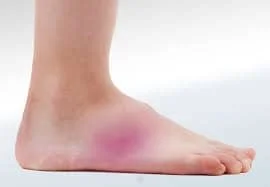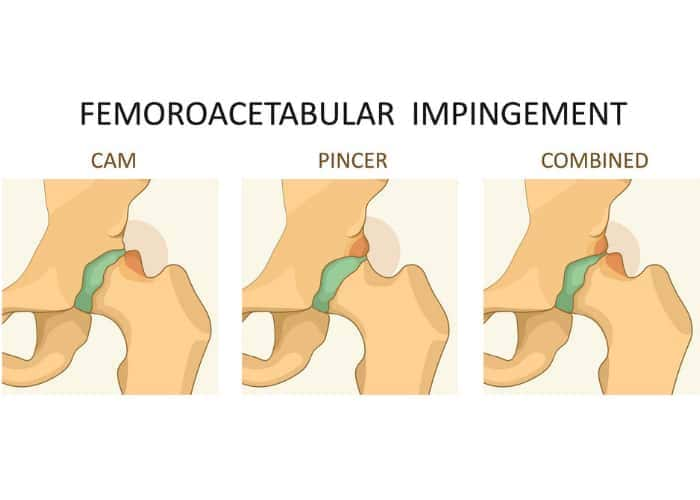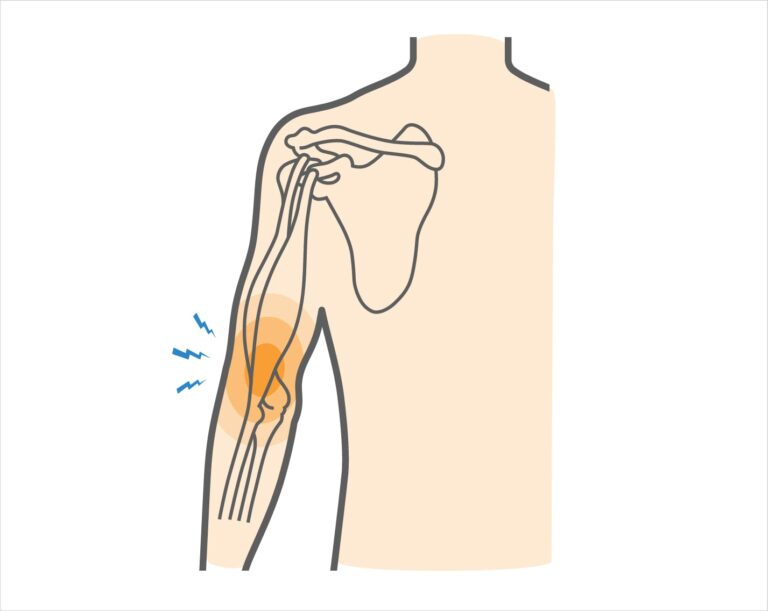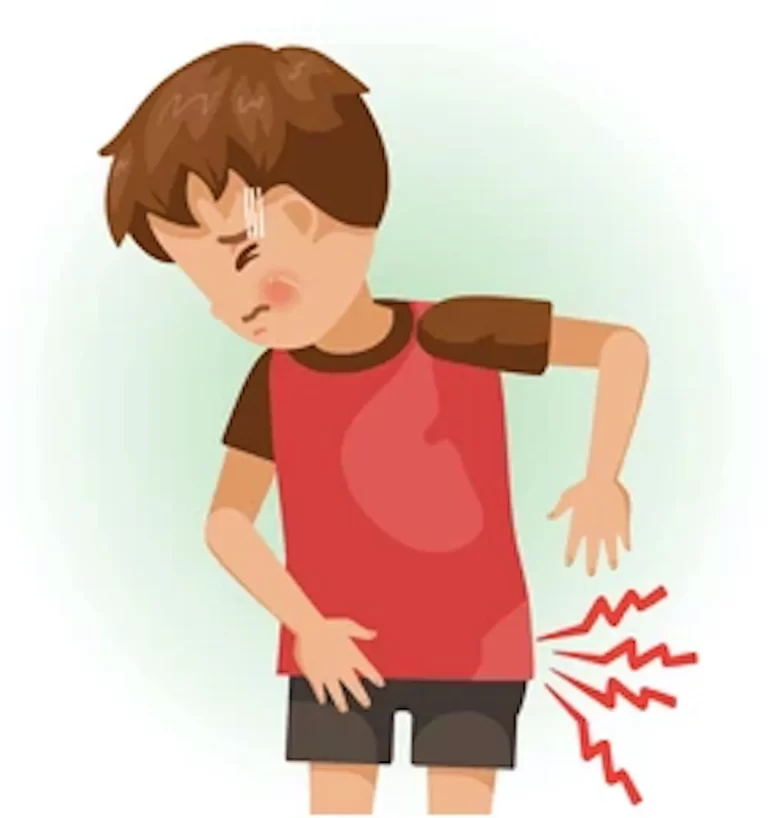Milkmaid’s Grip
Table of Contents
What is the Milkmaid’s Grip?
“Milkmaid’s grip,” a term derived from the hand position used by milkmaids while milking cows, refers to a type of hand injury that can result from prolonged and forceful gripping of objects. This injury is characterized by strain and discomfort in the hand muscles and tendons due to repetitive gripping motions.
It is named after the hand position used by milkmaids while milking cows. This repetitive gripping motion can lead to strain and discomfort in the hand muscles and tendons. If you’re experiencing hand pain or discomfort, it’s a good idea to take breaks and stretch your hand to avoid overexertion.
The “Milkmaid’s grip” injury can be caused by repetitive actions that involve holding onto an object with a strong grip for an extended period. This can include activities like using tools, playing musical instruments, or even excessive smartphone use. The sustained muscle tension and lack of proper rest can lead to strain and discomfort. It’s important to vary your hand movements and take breaks to prevent this type of injury. Some common groups of people who might be more prone to developing a “Milkmaid’s grip” injury include:
- Office Workers: Individuals who spend long hours typing, using a computer mouse, or performing repetitive tasks that involve gripping.
- Musicians: Musicians who play instruments that require prolonged gripping, such as string instruments, wind instruments, or percussion instruments.
- Manual Laborers: Workers who use hand tools or equipment that require forceful gripping, such as construction workers, carpenters, and mechanics.
- Artists and Crafters: People who engage in activities like painting, drawing, or crafting, which often involve prolonged use of hand tools or brushes.
- Gardeners: Individuals who engage in gardening tasks that involve gripping tools like shovels, rakes, and pruning shears for extended periods.
- Smartphone Users: Excessive use of smartphones with repetitive texting or scrolling motions can also contribute to hand strain and discomfort.
- Athletes: Some sports or recreational activities that involve gripping equipment, such as racquet sports or weightlifting, can also contribute to hand strain.
Causes of Milkmaid’s Grip
Certainly, in addition to repetitive gripping motions, other causes of “Milkmaid’s grip” or hand strain can include:
- Poor Ergonomics: Using tools or devices that are not ergonomically designed can lead to awkward hand positions and increased strain.
- Overexertion: Performing tasks that require excessive force or pressure on the hands without breaks can lead to muscle fatigue and strain.
- Lack of Conditioning: If your hand muscles aren’t conditioned for a specific activity, they may be more susceptible to strain.
- Inadequate Warm-up: Engaging in activities that require strong gripping without a proper warm-up can increase the risk of injury.
- Underlying Conditions: Certain medical conditions like arthritis, carpal tunnel syndrome, or tendinitis can make the hands more prone to strain.
- Improper Technique: Using incorrect hand positioning or technique while performing activities can contribute to hand strain.
- Repetitive Movements: Repeating the same hand movements repeatedly, whether for work or leisure, can lead to muscle imbalances and strain.
- Vibration Exposure: Prolonged exposure to vibrations from tools or machinery can contribute to muscle fatigue and hand strain.
Symptoms of Milkmaid’s Grip
Symptoms of “Milkmaid’s grip” or hand strain can vary, but they often include:
- Pain: You might experience a dull ache or sharp pain in the hand, wrist, or forearm during or after activities that involve gripping.
- Tightness: The muscles in your hand or forearm might feel tight or tense, especially when you try to move your fingers or wrist.
- Weakness: You might notice a decrease in grip strength or difficulty holding onto objects that you would normally be able to hold easily.
- Stiffness: Your hand might feel stiff or rigid, making it challenging to move your fingers or wrist comfortably.
- Tingling or Numbness: You could experience tingling sensations or even numbness in the hand or fingers, which might indicate nerve involvement.
- Swelling: In some cases, there might be mild swelling around the affected area.
- Redness or Warmth: The hand might appear slightly redder or feel warmer than usual due to increased blood flow.
- Limited Range of Motion: You might find it difficult to move your fingers or wrist through their full range of motion.
Diagnosis
Diagnosing “Milkmaid’s grip” or hand strain typically involves a combination of medical evaluation, physical examination, and sometimes imaging studies.
- Medical History: Your doctor will inquire about your symptoms, the activities that might be causing the strain, and any relevant medical history or underlying conditions.
- Physical Examination: A physical examination will focus on the affected hand, wrist, and forearm. Your doctor will assess your range of motion, muscle strength, and any signs of swelling, redness, or warmth.
- Diagnostic Tests: In some cases, your doctor might recommend diagnostic tests, such as X-rays or ultrasound, to rule out other possible causes of your symptoms, such as fractures, arthritis, or nerve issues.
- Electromyography (EMG): If nerve involvement is suspected, an EMG might be performed to assess the electrical activity of your muscles and nerves.
- Clinical Assessment: Based on the information gathered from your medical history, physical examination, and any test results, your doctor will make a clinical assessment to determine the likely cause of your hand strain.
Differential Diagnosis
- Carpal Tunnel Syndrome: This condition involves compression of the median nerve in the wrist, leading to symptoms like hand pain, tingling, and numbness, especially in the thumb, index, middle, and part of the ring finger.
- De Quervain’s Tenosynovitis: This is a condition that affects the tendons on the thumb side of the wrist joint. It can cause aches, swelling, and difficulty moving the thumb and wrist.
- Tendinitis: Inflammation of a tendon can cause localized pain and tenderness. Depending on which tendon is affected, you might experience pain during specific movements.
- Arthritis: Osteoarthritis or rheumatoid arthritis can cause joint pain, stiffness, and limited range of motion in the hand and wrist.
- Ganglion Cyst: These fluid-filled cysts often form around joints and tendons in the hand or wrist, causing pain and sometimes restricting movement.
- Trigger Finger: This condition causes one of the fingers to become stuck in a bent position and then snap straight with a clicking sensation. It’s due to inflammation in the tendon sheath.
- Dupuytren’s Contracture: This condition causes the tissues under the skin of the palm to thicken and tighten, leading to the fingers being pulled inward.
- Radial Tunnel Syndrome: Similar to carpal tunnel syndrome, this condition involves compression of the radial nerve, leading to pain and weakness in the forearm and hand.
- Nerve Entrapment: Apart from carpal tunnel and radial tunnel syndromes, other nerve entrapment issues can cause symptoms like pain, tingling, and numbness in specific areas of the hand.
- Fractures or Dislocations: Injuries to the hand, such as fractures or dislocations, can cause localized pain, swelling, and changes in the appearance of the hand.
- Infections: Infections can cause localized pain, redness, warmth, and swelling in the hand.
Medical treatment of Milkmaid’s Grip
Medical treatment for hand strain or “Milkmaid’s grip” generally focuses on relieving pain, reducing inflammation, and promoting healing.
Pain Relief: Over-the-counter pain relievers like ibuprofen medicine or acetaminophen medicine can help manage pain and decrease inflammation.
Corticosteroid Injections: In some cases, a doctor might recommend a corticosteroid injection to decrease inflammation and aches. These injections are usually administered directly to the affected area.
Physiotherapy treatment
A physical therapist can guide you through specific exercises to improve hand strength, flexibility, and range of motion. They may also teach you proper ergonomic techniques.
- Manual Therapy: Physiotherapists may use hands-on methods to mobilize and manipulate the affected joint area and soft tissues. This can help improve circulation, reduce muscle tension, and restore range of motion.
- Cold Therapy: Applying ice or cold packs to the affected area can help reduce swelling and relieve pain. Remember to use a cloth or barrier to protect the patient’s skin layer from direct contact with the ice.
- Therapeutic Exercises: Physiotherapists will guide you through specific exercises to improve hand strength, flexibility, and coordination. These exercises might involve squeezing therapy putty, using resistance bands, or performing finger and wrist stretches.
- Ergonomic Advice: Physiotherapists can provide guidance on proper hand positioning and ergonomic techniques for various activities, whether it’s work-related tasks or everyday activities.
- Nerve Gliding Exercises: If nerve involvement is suspected, your physiotherapist might teach you nerve gliding exercises to help improve nerve mobility and alleviate symptoms like tingling and numbness.
- Modalities: Physiotherapy modalities such as ultrasound, electrical stimulation, or heat/cold therapy might be used to reduce pain and promote healing.
- Splinting: Physiotherapists can recommend and custom-fit splints or braces that provide support to the affected area while still allowing for some movement.
Exercise
Finger Flexor Stretch:
- Gently straighten your fingers.
- Use your other hand to apply gentle pressure to the back of your hand, stretching your fingers back.
- Hold for 15-30 seconds, then release. Repeat a few times.
Finger Extensor Stretch:
- Place your hand on a flat surface with your palm down.
- Use your other hand to gently bend your fingers backward, feeling a stretch in the palm and fingers.
- Hold for 15-30 seconds, then release. Repeat a few times.
Wrist Flexor Stretch:
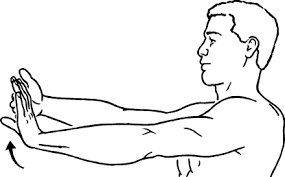
- Hold your arm straight out in front of the patient with your palm facing down.
- Use your other hand to normally bend your wrist downward.
- Hold for 15-30 seconds, then release. Repeat 5 to 7 times.
Wrist Extensor Stretch:
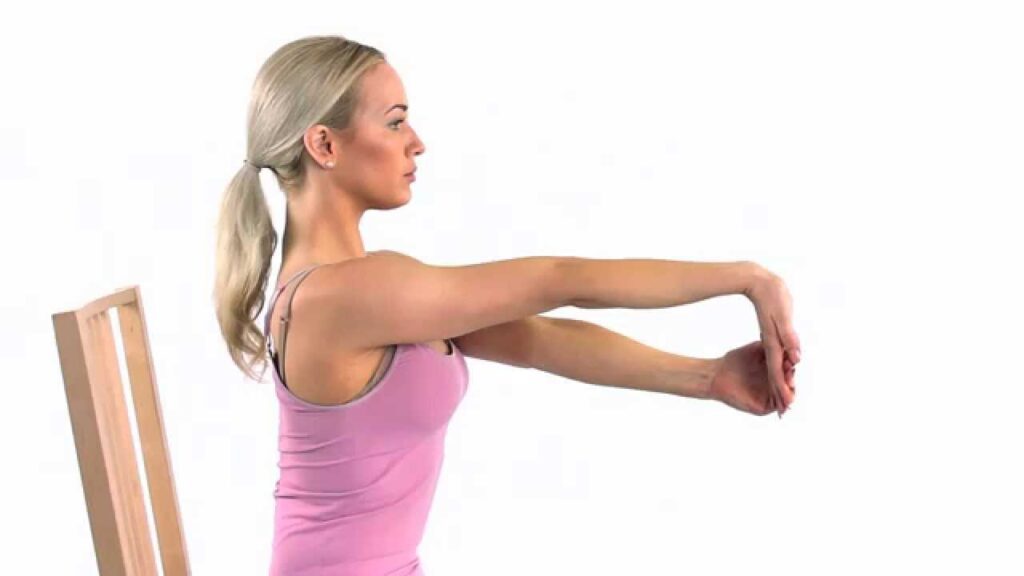
- Hold your arm straight out in front of the patient with your palm facing up.
- Use your other hand to flex your wrist upward.
- Hold for 15-30 seconds, then release. Repeat 5 to 7 times.
Grip Strengthening with Therapy Putty:
- Squeeze and release a soft therapy putty (available at medical supply stores) in various hand positions and directions.
- Gradually increase the resistance as the patient’s strength improves.
Finger Pinch Exercise:
- Place a small object (such as a coin or button) between your thumb and each finger, one at a time.
- Pinch and release the object using each finger, repeating many times.
Wrist Rotations:
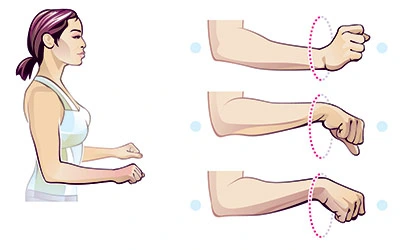
- Hold your arm out in front of you with your elbow flexed at 90 degrees.
- Slowly rotate the patient wrist in circular motions, both clockwise and counterclockwise.
Finger Tapping:
- Tap each finger individually against your thumb, starting with your index finger and moving to your pinky finger.
- normally improves the speed and intensity.
Ball Squeeze:
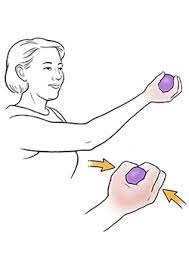
- Hold a soft ball or stress ball in the patient’s hand.
- Squeeze the ball and hold for 10 to 20 seconds, then release.
- Repeat the squeezing motion many times.
Thumb Stretch:
- Hold your hand out with the patient’s palm facing you.
- Normally pull your thumb across your palm, toward the base of your pinky finger.
- Hold for 15-30 seconds, then release. Repeat 5 to 7 times on each hand.
Wrist Flexor Strengthening:
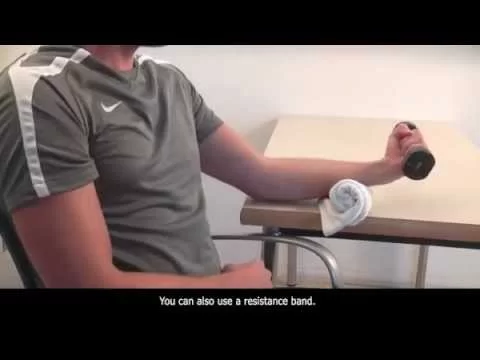
- Hold a light hand weight or a water bottle in your hand with the patient’s palm facing up.
- Slowly flex the patient’s wrist upward and then lower it.
- Repeat for a set of repetitions, gradually increasing the weight as the patient feels comfortable.
Wrist Extensor Strengthening:

- Place the patient’s forearm on a table with your hand hanging off the edge, palm facing down.
- Hold a lightweight (such as a small dumbbell) in your hand.
- Slowly lift the weight by bending your wrist upward and then lowering it.
- Repeat for 5 to 7 time of repetitions, gradually increasing the weight.
Finger Resistance Band Exercise:
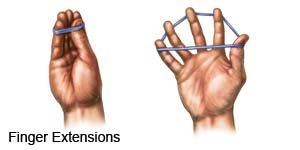
- Wrap a resistance band around the patient’s fingers.
- Open your fingers against the resistance of the band, then slowly close your fingers.
- Repeat for 5 to 7 time of repetitions.
Wrist Radial Deviation Exercise:
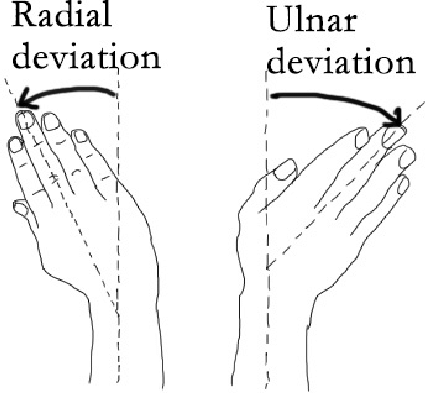
- Hold a small weight in your hand with the patient’s palm facing up.
- Tilt your hand towards your thumb side (radial deviation), then back to the neutral position.
- Repeat for 5 to 7 time of repetitions.
Wrist Ulnar Deviation Exercise:

- Hold a small weight in your hand with your palm facing up.
- Tilt your hand towards your pinky side (ulnar deviation), then return to the neutral position.
- Repeat for 5 to 4 time of repetitions.
Finger Walking Exercise:
- Place the patient’s hand on a flat surface with your fingers spread.
- Lift each finger one at a time, starting with the pinky, then place it back down.
- Repeat for all fingers, gradually increasing the speed.
Thumb Opposition Exercise:
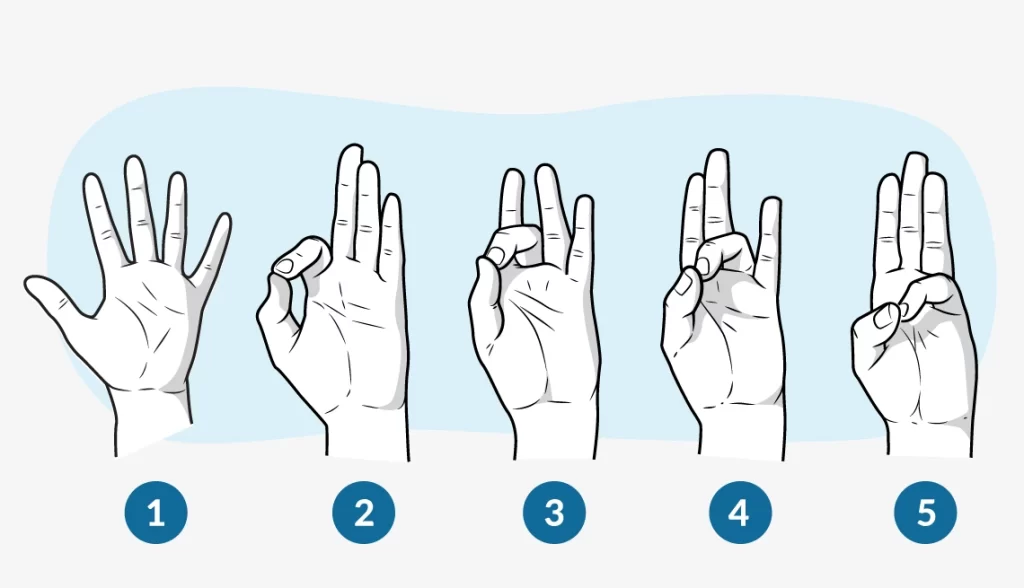
- Touch the patient’s thumb to each fingertip, one at a time.
- Repeat several times, making sure your thumb moves independently.
Finger Extension Using a Rubber Band:
- Around the outside of your fingers, wrap a rubber band.
- Spread your fingers against the resistance of the rubber band and hold for a few seconds.
- Release and repeat for 15 to 20 time of repetitions.
Finger Fan Exercise:
- Hold out your fingers far apart for a short while.
- Gradually bring your fingers back together, touching each fingertip to its corresponding fingertip on the opposite hand.
- Repeat the spreading and fanning motion several times.
Finger Lifts with a Towel:
- Place a small towel flat on an object like a table.
- Use your fingers to pinch and lift the towel off the table, one corner at a time.
- Hold the lifted corners for a few seconds before lowering them back down.
Thumb Opposition Stretch:
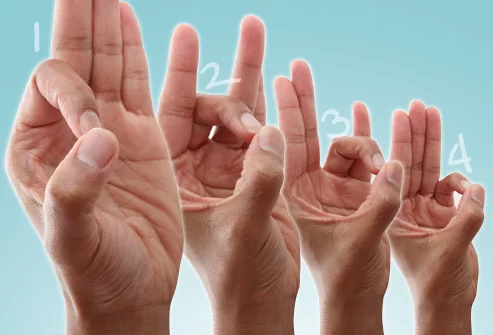
- Touch the tip of your thumb to the tip of each finger, creating a circle shape with your thumb and finger.
- Gently press your thumb against each finger, feeling a stretch in the base of your thumb.
- Hold for a few seconds and repeat for each finger.
Finger Tendon Gliding:
- Start with the patient’s fingers and thumb extended straight.
- Gently curl your fingers into a fist, then slowly straighten them again.
- Continue this motion, curling and extending your fingers one segment at a time.
Finger Piano Exercise:
- Place the patient’s hand flat on an object.
- Lift each finger individually, one at a time, keeping the other fingers down.
- Lower the lifted finger and move on to the next finger until you’ve lifted each one.
Thumb Circle Exercise:
- Hold your hand in a relaxed position.
- Gently move your thumb in a circular motion, making circles in both directions.
- Focus on moving your thumb at the base joint while keeping the other joints stable.
Finger Squeeze Ball Exercise:
- Hold a soft squeeze ball or stress ball in your hand.
- Squeeze the ball as hard as you comfortably can, holding for a few seconds.
- Release and repeat the 15 to 20-time squeezing motion.
Finger Touch Typing Exercise:
- Imagine a patient typing on a keyboard.
- Tap each finger on your opposite thumb as if you’re typing, moving through all the fingers.
Wrist Stretch with Overhead Reach:
- Extend one arm overhead with your palm facing forward. Use your other hand to gently bend your wrist backward, feeling a stretch along the underside of your forearm.
- Hold for a few seconds and switch the other sides.
- Education: Understanding your condition is key to managing it effectively. Physiotherapists can educate you about your hand strain, its causes, and how to prevent future occurrences.
- Home Exercise Program: Your physiotherapist will likely provide you with a set of exercises and stretches to perform at home. Consistently following the home exercise program can significantly contribute to your recovery.
- Progress Monitoring: Throughout your treatment, your physiotherapist will monitor your progress and adjust the treatment plan as needed to ensure you’re getting the best results.
- Preventive Strategies: Physiotherapists often focus on teaching strategies to prevent future hand strain by incorporating proper techniques and habits into your daily routines.
Surgical Treatment
Surgery for hand strain or “Milkmaid’s grip” is typically considered only when conservative treatments have not provided sufficient relief and the condition significantly impacts your daily life and functionality. Surgical options can vary depending on the underlying cause of the strain. It’s important to consult with a medical professional to determine whether surgery is necessary and which specific procedure might be appropriate for your situation.
- Carpal Tunnel Release Surgery: For severe cases of carpal tunnel syndrome, where the median nerve is compressed, a surgeon might perform a carpal tunnel release. This procedure involves cutting the ligament that’s pressing on the nerve to relieve the pressure.
- Tendon Repair: If a tendon has been damaged or torn due to strain or injury, surgical repair might be necessary to restore proper function. This is often done through small incisions and specialized techniques.
- Ganglion Cyst Removal: If a ganglion cyst is causing pain or interfering with hand movement, a surgeon can remove the cyst and sometimes the nearby tissue to prevent a recurrence.
- Trigger Finger Release: In cases of trigger finger, where a tendon becomes inflamed or thickened, surgery involves releasing the tendon sheath to allow smoother movement of the affected finger.
- Dupuytren’s Contracture Release: For severe cases of Dupuytren’s contracture, a condition that causes finger bending and tightening, a surgeon might perform a fasciectomy surgery or fasciotomy surgery to release the contracted tissue.
- Joint Fusion: In some cases of severe arthritis, joint fusion might be performed to alleviate pain and stabilize the joint. The bones on either side of the joint are fused together in this process.
- Wrist Arthroscopy: This minimally invasive procedure involves inserting a tiny camera and specialized tools into the wrist joint through small incisions. It can be used for diagnostic purposes or to treat certain wrist conditions.
- Nerve Decompression: If nerve compression is causing symptoms, a surgeon might perform a procedure to decompress the affected nerve, allowing it to function properly.
Prevention
Preventing hand strain or “Milkmaid’s grip” involves adopting healthy habits and ergonomic practices to minimize the risk of overexertion and repetitive stress on your hands. :
- Maintain Proper Posture: Maintain good posture while working or engaging in activities that involve your hands. Keep your wrists and hands in a neutral position to reduce strain.
- Take Regular Breaks: When performing tasks that require gripping or repetitive motions, take short breaks to stretch your hands and fingers.
- Ergonomic Workspace: Arrange your workspace to promote ergonomic hand positioning. Use tools and equipment that are designed to decrease strain on the patient’s hands and wrists.
- Alternate Activities: If your work or hobbies involve repetitive hand movements, try to vary your tasks throughout the day to prevent the overuse of specific muscles.
- Hand Strengthening Exercises: Engage in regular hand and wrist exercises to improve strength and flexibility. These exercises can help build endurance and protect against strain.
- Proper Tools and Equipment: Use tools and equipment that are appropriately sized for your hand and provide ergonomic support. This can reduce the effort required for tasks.
- Stretching Routine: Incorporate regular hand and wrist stretches into your daily routine, especially before and after engaging in activities that require hand use.
- Warm-Up: Warm up your hands with gentle movements before engaging in activities that involve forceful gripping.
- Avoid Overexertion: Be mindful of how much force you’re applying when gripping objects. Avoid unnecessary force that can strain your hand muscles and tendons.
- Hydration and Nutrition: Proper hydration and a balanced diet can support overall muscle health and reduce the risk of cramping and discomfort.
- Wrist Supports: If needed, use wrist supports, braces, or splints to provide additional stability during activities that strain your hands.
- Proper Technique: Learn and use proper techniques for tasks that involve your hands. This can reduce the strain on your muscles and tendons.
- Stay Active: Engage in regular physical activity to maintain overall muscle and joint health. Staying active can also improve blood circulation to your hands.
- Listen to Your Body: Pay attention to any discomfort or pain in the patient’s hands. If you start to feel strain or pain, take a break and practice self-care.
- Manage Stress: High levels of stress can lead to muscle tension. Engage in relaxation techniques to manage stress and tension that might affect your hands.
Home Advice
Certainly, here are some practical home advice and tips to help manage and prevent hand strain or discomfort:
- Create an Ergonomic Workspace: Arrange your workspace to support good hand and wrist posture. Adjust your chair, desk, and computer setup to maintain neutral wrist positions while typing or using a mouse.
- Use Proper Tools: Choose tools and utensils with ergonomic designs that reduce the need for excessive gripping or forceful movements.
- Frequent Hand Stretches: Integrate regular hand and wrist stretches into your daily routine, especially if you’re engaging in repetitive activities.
- Hydration: Stay well-hydrated to ensure your muscles are functioning optimally. Dehydration can lead to muscle cramps and stiffness.
- Warm-Up: Before engaging in tasks that require using your hands, take a few minutes to gently move and stretch your fingers and wrists.
- Use Padding: When performing activities that involve prolonged pressure on your hands, like gardening, use padded gloves or cushioned surfaces to reduce strain.
- Rest Breaks: If you’re involved in repetitive tasks, take short breaks to rest your hands and perform gentle stretches.
- Alternate Hands: Whenever possible, alternate between using your dominant and non-dominant hands to distribute the load and avoid overuse.
- Ice Packs: If you experience swelling or discomfort, apply ice packs to the affected area for about 15-20 minutes to reduce inflammation.
- Hand Cream: Use moisturizing hand creams to keep your skin supple. Dry skin can become more prone to discomfort.
- Finger and Hand Exercises: Incorporate hand exercises using therapy putty or rubber bands to maintain hand strength and flexibility.
- Mindful Smartphone Use: Avoid excessive or prolonged smartphone use that requires continuous gripping. Take breaks to stretch your fingers.
- Cushioned Grips: Attach cushioned grips or handles to tools or utensils to reduce the amount of force needed to hold them.
- Supportive Pillows: Use supportive pillows or cushions to keep your wrists in a neutral position while sleeping.
- Mind Your Posture: Maintain good overall posture, as poor posture can contribute to strain on the entire upper body, including the hands.
- Stay Active: Engage in regular physical activity to promote overall circulation and muscle health. Activities like yoga or swimming can be gentle on the hands.
- Reduce Stress: Engage in stress-reduction techniques such as deep breathing, meditation, or mindfulness to prevent tension from affecting your hands.
FAQ
Poor Ergonomics: Using tools or devices that are not ergonomically designed can lead to awkward hand positions and increased strain.
Overexertion: Performing tasks that require excessive force or pressure on the hands without breaks can lead to muscle fatigue and strain
Tingling or Numbness: You could experience tingling sensations or even numbness in the hand or fingers, which might indicate nerve involvement.
muscle tightness: The muscles in your hand or forearm might feel tight or tense, especially when you try to move your fingers or wrist.
Swelling: There might be mild swelling around the affected area.
Limited Range of Motion: You might find it difficult to move your fingers or wrist through their full range of motion.
Finger Flexor Stretch: Gently straighten your fingers. Use your other hand to apply gentle pressure to the back of your hand, stretching your fingers back. Hold for 15-30 seconds, then release. Repeat a few times.
Finger Extensor Stretch: Place your hand on a flat surface with your palm down. Use your other hand to gently bend your fingers backward, feeling a stretch in the palm and fingers.
Hold for 15-30 seconds, then release. Repeat a few times.
Ball Squeeze: Hold a soft ball or stress ball in the patient’s hand. Squeeze the ball and hold for 10 to 20 seconds, then release. Repeat the squeezing motion many times.
Maintain Proper Posture: Maintain good posture while working or engaging in activities that involve your hands. Keep your wrists and hands in a neutral position to reduce strain.
Alternate Activities: If your work or hobbies involve repetitive hand movements, try to vary your tasks throughout the day to prevent the overuse of specific muscles.
Proper Technique: Learn and use proper techniques for tasks that involve your hands. This can reduce the strain on your muscles and tendons.


